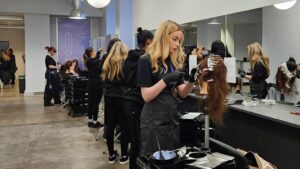
The Basement Gym + Studio opens in Camden Town
Camdenist readers get 50% off their first month’s membership, too

In this new 15-minute documentary, local audio artist and writer, Ivan d’Avoine, sits down with Mario Saggese, proprietor of the eponymously named Café, to hear the story of how it’s stayed in his family for so long. Mario’s has also been a favoured haunt of musicians since the early 90’s, inspiring this ethereal homage by St Etienne, and witnessing a particularly infamous day that reggae royalty Lee Scratch Perry came for breakfast…
In your audio documentary, you say, “marks don’t always survive but stories do.” Why is sound your chosen format for telling stories?
To begin with, audio and podcasting were just a convenient medium for me, in a technical sense, having had previous experience in sound design and music production. However, I soon realised that in the act of listening as opposed to watching, the capacity of the imagination is enhanced. I think that if done right, the aural story is the most ‘visual’ even if its perceived limitation is the visual dimension.
An aural story becomes less singular once it is told, and less objective, it is no longer the property of the teller but something that becomes unique to the individual listener, which reflects their own experiences and images of the world. It’s almost like a collaborative process between the producer and the listener. After all, it’s the listener who creates the images in their head with sound encouragement. As Jay Allison writes: “Images are indelible because we participate in their creation.”
I think the scope for imagination and interpretation means more for immersion and less for passivity, and that’s what you want from a story: to feel alive. An audio documentary of Mario’s Cafe brings it to life.

What drew you to tell this story?
There are two stories that are told in this audio doc. The first is the story of Mario’s Cafe and the Saggese family. The second is the story of when Lee Scratch Perry turned up at the cafe in October 2017. One goes back over fifty years, whilst the other only over a couple of hours, but both are connected, and I think complement each other in exploring bigger themes like migration, leaving marks, community and so on.
I was drawn to the idea of profiling Mario’s Cafe, having frequented the place since I first went there with friends on my school lunch break. It doesn’t feel like your normal cafe, and I’ve always felt a special connection to the place even whilst not a regular anymore. The charisma and warmth of Mario himself is the driving force behind the special aura that the cafe holds for so many of us, and I was hopeful in trying to capture that essence.
Reading the Camden New Journal, I learnt that Lee Scratch Perry had visited Mario’s. Since then that story of him nailing a 20p coin into a tree outside the cafe, without any apparent reason, has stuck with me. At the time I wasn’t exactly familiar with Perry’s music but I knew who he was, and picturing him at Mario’s intrigued me. It felt like two worlds were colliding, both plucked from opposite parts of my consciousness; dreamlike almost. The coin and the tree then reinforced the random familiarity that we feel when dreaming.
When I decided to profile Mario’s Cafe in response to a brief sent by the Migration Museum, loosely based around the theme, Heart of the Community, I knew I had to somehow incorporate the Lee Scratch Perry story even if I didn’t quite know how at the time. Whilst being a small and at the time ‘meaningless’ act, the 20p tree felt symbolic of something that was bigger. It felt like an audio documentary of Mario’s Cafe would be the perfect place to start.

What does Mario’s Cafe mean to you?
It represents familiarity and community at a time when businesses are constantly changing hands, especially in Kentish Town and Camden Town. This quote from my friend Emil neatly articulates this sentiment held by many of us: “even just this table is associated with Mario’s now, like this pattern, the colours of it. So many times I’ve spent sitting out on this street with people I like… who are special to me.”
The place feels like it’s never changed and that it’s never had to, at least since 2014 when I first went there. Maybe it reminds me that I’m getting older or, since it’s hardly changed, maybe it helps me to forget that!
There isn’t a particular memory that stands out to me from being at Mario’s over the years, but perhaps rather a feeling or spirit that is consistently present and the same. One that includes safety in knowing that you can be yourself within that space. You never feel like the next customer paying for a service because Mario has created an environment where everyone also feels like they themselves are contributing in a small way to the space. This communal essence is maybe best highlighted in the exhibitions Mario puts up every month, inviting artists and photographers to showcase their work on the walls.
Why is telling stories like this important?
They help to remind us of the things in life that are often taken for granted. Mario’s Cafe has been there since 1958 (originally named Tony’s Restaurant) and so from time to time, we might need reminding of its significance within our lives.
Too often, people realise their appreciation for a person once they have gone and this is the same for a place as well, particularly one that’s been ever-present within a community. It’s important to elevate and celebrate local institutions like Mario’s Cafe whilst they are here, especially in continuing periods of instability and precariousness that have led to the closures of businesses across the country.
Stories that lift every day to the forefront of the imagination, that allow people’s voices to emerge, and that engage the listener with the means to reflect on their own lives and places in the world are important.
This line from Sherre DeLys I think beautifully captures the position that audio storytellers can occupy: “[as radio documentarians] we move in the space between the spirit and every day, where the common becomes uncommonly beautiful”.
What’s your favourite thing to eat at Mario’s?
It has to be the chicken, pesto and mozzarella ciabatta toasties for me. It never disappoints.
We hope you enjoy this audio documentary of Mario’s Cafe and check out more stories via Camdenist.


Camdenist readers get 50% off their first month’s membership, too

A brand new hairdressing and barbering academy has landed in Camden Town and is now seeking style-conscious models and enthusiastic trainees

We speak to founder, Sol, about bringing the studio to Kentish Town

Explore the neighbourhood’s brand new neighbourhood